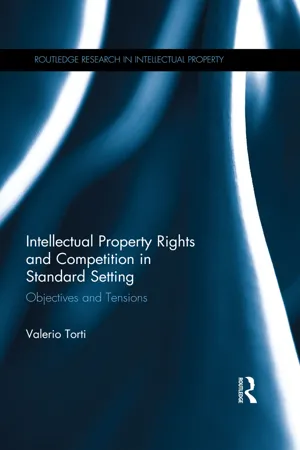
Intellectual Property Rights and Competition in Standard Setting
Objectives and tensions
- 252 pages
- English
- ePUB (mobile friendly)
- Available on iOS & Android
Intellectual Property Rights and Competition in Standard Setting
Objectives and tensions
About this book
Competition and intellectual property rights (IPRs) are both necessary for a market to work efficiently and to promote consumer welfare. Properly applied, intellectual property rules define a legal framework which allows undertakings to profit from their inventions. This in turn encourages competition among firms and enhances dynamic efficiency, to the benefit of consumer welfare. Standard setting represents one of the fields where the interaction between competition law and IPRs clearly comes to light. The collaborative goal of standard setting organizations (SSOs) is to adopt and promote standards that either do not conflict with anyone's right or, if they do, are developed under condition that patents are licensed under defined terms.
This book examines the tension between IPRs and competition in the standard setting field which can arise when innovators over-exploit the rights they have been granted and hold up an entire industry. The book compares EU and U.S. jurisdictions with a particular focus on the IT and telecommunication sectors. It scrutinizes those practices which could harm standard setting and its goals, looking at misleading conducts by SSOs' members which may lead to breach the EU and U.S. antitrust provisions on abuse of market power. Recent developments in EU and U.S. standard setting are analysed highlighting the differences in enforcement approaches. The book considers how the optimal balance between IPRs and industry standards can be struck, suggesting a policy model which takes into account both innovators' interests and SSOs' goals.
Frequently asked questions
- Essential is ideal for learners and professionals who enjoy exploring a wide range of subjects. Access the Essential Library with 800,000+ trusted titles and best-sellers across business, personal growth, and the humanities. Includes unlimited reading time and Standard Read Aloud voice.
- Complete: Perfect for advanced learners and researchers needing full, unrestricted access. Unlock 1.4M+ books across hundreds of subjects, including academic and specialized titles. The Complete Plan also includes advanced features like Premium Read Aloud and Research Assistant.
Please note we cannot support devices running on iOS 13 and Android 7 or earlier. Learn more about using the app.
Information
IPRs, competition and the standards
1
The objectives of competition law
1 Interpreting the goals of competition
1.1 Different policies and different objectives
2 Competition law as a means to achieving different aims
2.1 Ensuring an effective competitive process
2.1.1 Effective competition: a means or an aim?
Table of contents
- Cover
- Title
- Copyright
- Contents
- Acknowledgements
- Forewords
- Table of cases
- Table of legislation
- Introduction
- PART ONE IPRs, competition and the standards
- PART TWO Anticompetitive conduct and standardization
- PART THREE Reconciling IPRs and competition in standard setting
- Bibliography
- Index